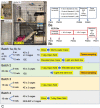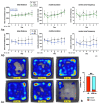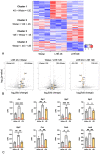Rearing in an Enriched Environment Ameliorates the ADHD-like Behaviors of Lister Hooded Rats While Suppressing Neuronal Activities in the Medial Prefrontal Cortex
- PMID: 36429076
- PMCID: PMC9688563
- DOI: 10.3390/cells11223649
Rearing in an Enriched Environment Ameliorates the ADHD-like Behaviors of Lister Hooded Rats While Suppressing Neuronal Activities in the Medial Prefrontal Cortex
Abstract
In addition to genetic factors, environmental factors play a role in the pathogenesis of attention deficit/hyperactivity disorder (ADHD). This study used Lister hooded rats (LHRs) as ADHD model animals to evaluate the effects of environmental factors. Male LHR pups were kept in four rearing conditions from postnatal day 23 (4 rats in a standard cage; 12 rats in a large flat cage; and 4 or 12 rats in an enriched environment [EE]) until 9 weeks of age. EE rearing but not rearing in a large flat cage decreased the activity of LHRs in the open field test that was conducted for 7 consecutive days. In the drop test, most rats reared in an EE remained on a disk at a height, whereas most rats reared in a standard cage fell off. RNA sequencing revealed that the immediate-early gene expression in the medial prefrontal cortex of LHRs reared in an EE was reduced. cFos-expressing neurons were reduced in number in LHRs reared in an EE. These results suggest that growing in an EE improves ADHD-like behaviors and that said improvement is due to the suppression of neuronal activity in the mPFC.
Keywords: LHR; RNAseq; cFos; enriched environment; immediate-early gene; prefrontal cortex.
Conflict of interest statement
The authors declare no competing interests.
Figures








Similar articles
-
Lister hooded rats as a novel animal model of attention-deficit/hyperactivity disorder.Neurochem Int. 2020 Dec;141:104857. doi: 10.1016/j.neuint.2020.104857. Epub 2020 Sep 30. Neurochem Int. 2020. PMID: 33010392
-
Rearing in an enriched environment attenuated hyperactivity and inattention in the Spontaneously Hypertensive Rats, an animal model of Attention-Deficit Hyperactivity Disorder.Physiol Behav. 2016 Mar 1;155:30-7. doi: 10.1016/j.physbeh.2015.11.035. Epub 2015 Nov 30. Physiol Behav. 2016. PMID: 26656767
-
Isolation rearing impairs wound healing and is associated with increased locomotion and decreased immediate early gene expression in the medial prefrontal cortex of juvenile rats.Neuroscience. 2008 Jan 24;151(2):589-603. doi: 10.1016/j.neuroscience.2007.10.014. Epub 2007 Oct 24. Neuroscience. 2008. PMID: 18063315 Free PMC article.
-
Hypodopaminergic and hypernoradrenergic activity in prefrontal cortex slices of an animal model for attention-deficit hyperactivity disorder--the spontaneously hypertensive rat.Behav Brain Res. 2002 Mar 10;130(1-2):191-6. doi: 10.1016/s0166-4328(01)00425-9. Behav Brain Res. 2002. PMID: 11864734 Review.
-
The spontaneously hypertensive-rat as an animal model of ADHD: evidence for impulsive and non-impulsive subpopulations.Neurosci Biobehav Rev. 2003 Nov;27(7):639-51. doi: 10.1016/j.neubiorev.2003.08.007. Neurosci Biobehav Rev. 2003. PMID: 14624808 Review.
Cited by
-
N-Acetylcysteine Alleviates Depressive-Like Behaviors in Adolescent EAAC1-/- Mice and Early Life Stress Model Rats.Int J Biol Sci. 2024 Oct 7;20(14):5450-5473. doi: 10.7150/ijbs.97723. eCollection 2024. Int J Biol Sci. 2024. PMID: 39494328 Free PMC article.
-
Environmental enrichment reverses prenatal ethanol exposure-induced attention-deficits in rats.Front Psychiatry. 2025 Mar 26;16:1549318. doi: 10.3389/fpsyt.2025.1549318. eCollection 2025. Front Psychiatry. 2025. PMID: 40230820 Free PMC article.
References
Publication types
MeSH terms
LinkOut - more resources
Full Text Sources
Medical
Miscellaneous

